TOYOTA RAV4 PLUG-IN HYBRID 2022 Owners Manual
Manufacturer: TOYOTA, Model Year: 2022, Model line: RAV4 PLUG-IN HYBRID, Model: TOYOTA RAV4 PLUG-IN HYBRID 2022Pages: 662, PDF Size: 163.06 MB
Page 271 of 662
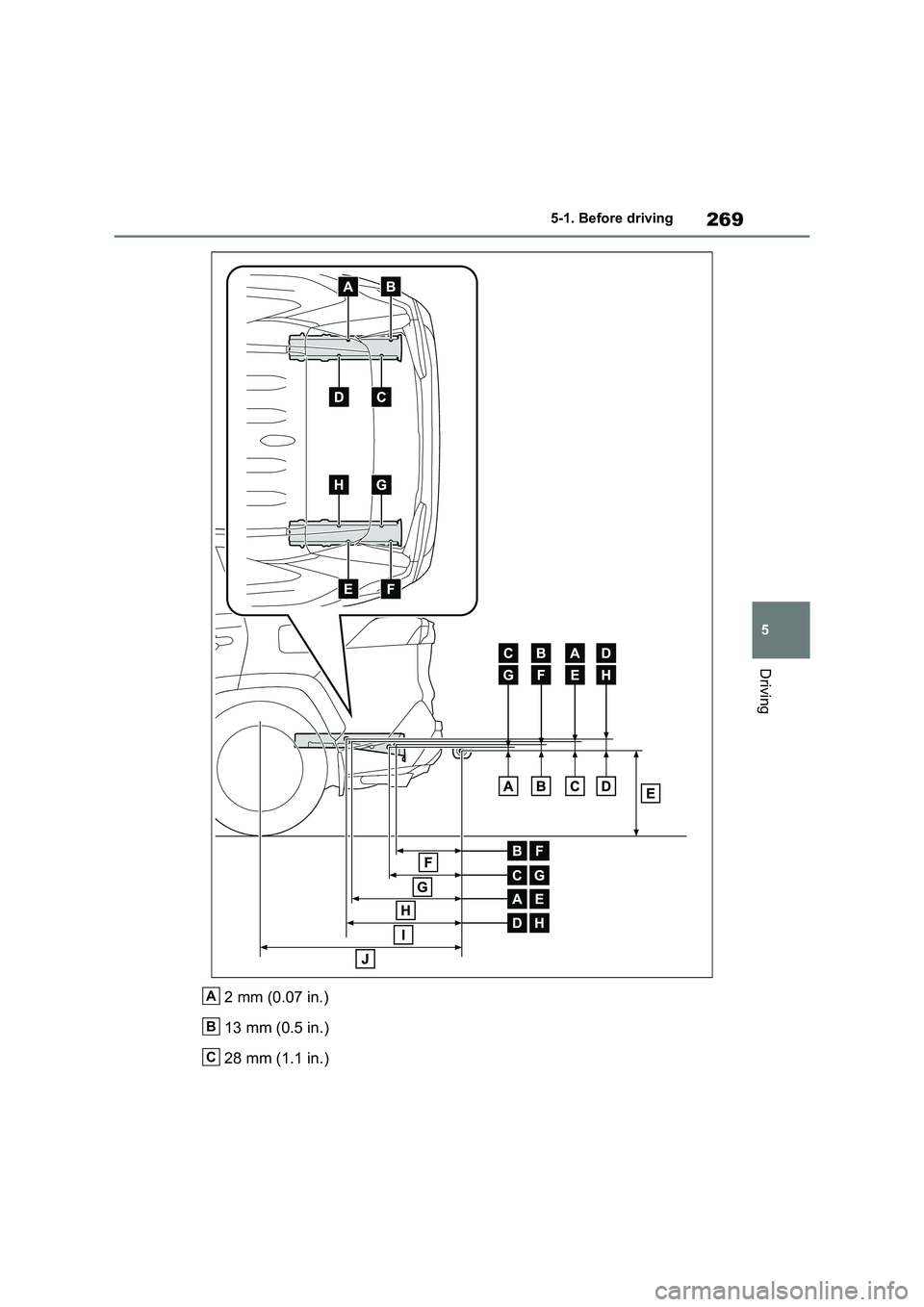
269
5 5-1. Before driving
Driving
2 mm (0.07 in.)
13 mm (0.5 in.)
28 mm (1.1 in.)A
B
C
Page 272 of 662

2705-1. Before driving
34 mm (1.3 in.)
412 mm (16.2 in.)
332 mm (13.1 in.)
370 mm (14.6 in.)
570 mm (22.4 in.)
601 mm (23.7 in.)
1073 mm (42.2 in.)
Your vehicle will handle differently
when towing a trailer. In order to
avoid accident, death or serious
injury, keep the following in mind
when towing:
�QChecking connections
between trailer and lights
Stop the vehicle and check the
operation of the connection
between the trailer and lights after
driving for a brief period as well as
before starting off.
�QPracticing driving with a cou-
pled trailer
Get the feel for turning, stopping
and reversing with the trailer
coupled by practicing in an area
with no or light traffic.
When reversing with a coupled
trailer, hold the section of the
steering wheel nearest to you
and rotate clockwise to turn the
trailer left or counterclockwise to
turn it right. Always rotate a little
at a time to prevent steering
error. Have someone guide you
when reversing to lessen the risk
of an accident.
�QIncreasing vehicle-to-vehicle
distance
At a speed of 10 km/h (6 mph), the
distance to the vehicle running
ahead of you should be equivalent
to or greater than the combined
length of your vehicle and trailer.
Avoid sudden braking that may
cause skidding. Otherwise, the
vehicle may spin out of control. This
is especially true when driving on
wet or slippery road surfaces.
D
E
F
G
H
I
J
NOTICE
�QWhen the rear bumper strength-
ening material is aluminum
Ensure the steel bracket part does not come directly in contact with that
area.
When steel and aluminum come into contact, there is a reaction similar to
corrosion, which will weaken the sec- tion concerned and may result in damage. Apply a rust inhibitor to parts
that will come in contact when attach- ing a steel bracket.
Guidance
Page 273 of 662
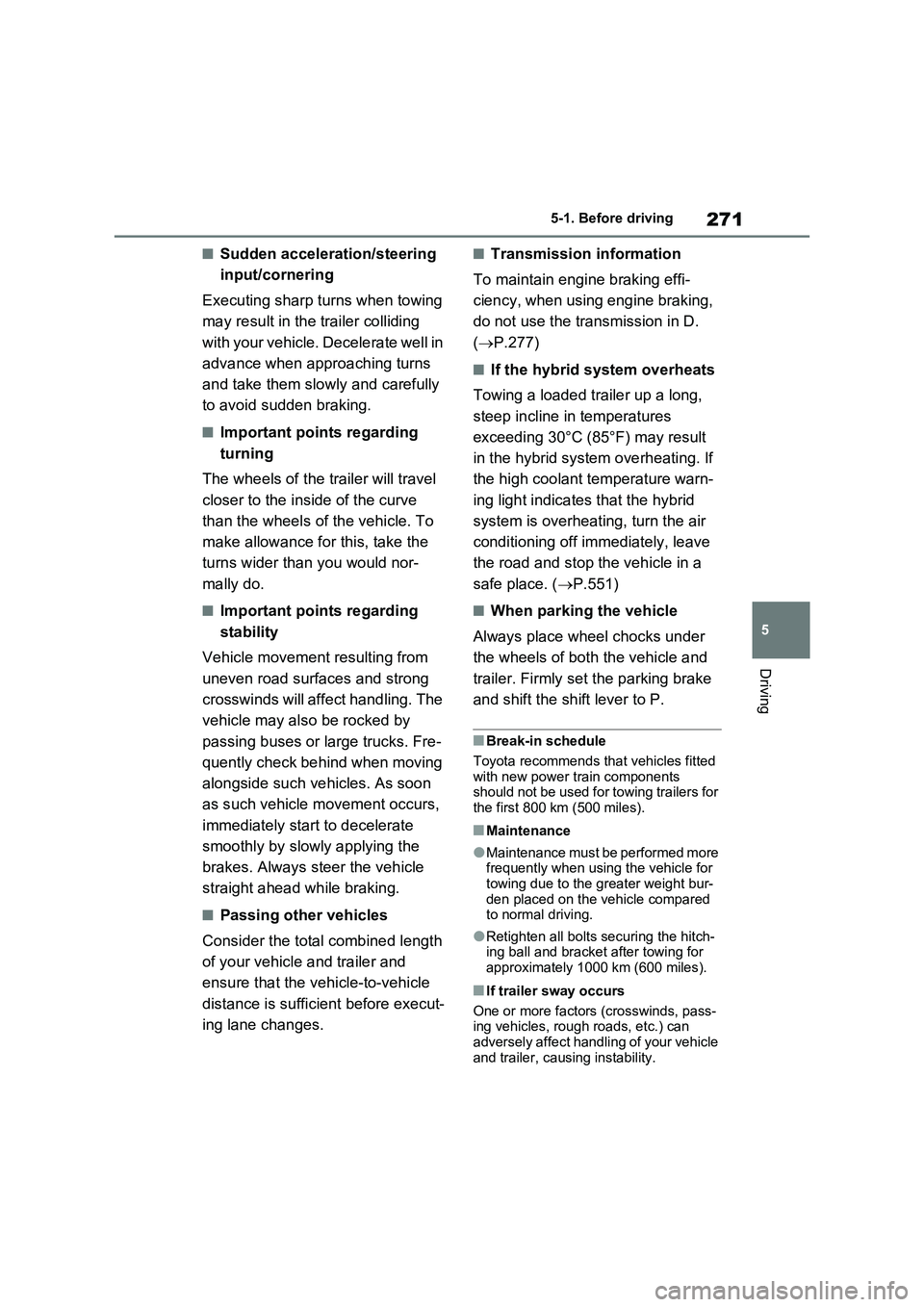
271
5 5-1. Before driving
Driving
�QSudden acceleration/steering
input/cornering
Executing sharp turns when towing
may result in the trailer colliding
with your vehicle. Decelerate well in
advance when approaching turns
and take them slowly and carefully
to avoid sudden braking.
�QImportant points regarding
turning
The wheels of the trailer will travel
closer to the inside of the curve
than the wheels of the vehicle. To
make allowance for this, take the
turns wider than you would nor-
mally do.
�QImportant points regarding
stability
Vehicle movement resulting from
uneven road surfaces and strong
crosswinds will affect handling. The
vehicle may also be rocked by
passing buses or large trucks. Fre-
quently check behind when moving
alongside such vehicles. As soon
as such vehicle movement occurs,
immediately start to decelerate
smoothly by slowly applying the
brakes. Always steer the vehicle
straight ahead while braking.
�QPassing other vehicles
Consider the total combined length
of your vehicle and trailer and
ensure that the vehicle-to-vehicle
distance is sufficient before execut-
ing lane changes.
�QTransmission information
To maintain engine braking effi-
ciency, when using engine braking,
do not use the transmission in D.
(P.277)
�QIf the hybrid system overheats
Towing a loaded trailer up a long,
steep incline in temperatures
exceeding 30°C (85°F) may result
in the hybrid system overheating. If
the high coolant temperature warn-
ing light indicates that the hybrid
system is overheating, turn the air
conditioning off immediately, leave
the road and stop the vehicle in a
safe place. (P.551)
�QWhen parking the vehicle
Always place wheel chocks under
the wheels of both the vehicle and
trailer. Firmly set the parking brake
and shift the shift lever to P.
�QBreak-in schedule
Toyota recommends that vehicles fitted
with new power train components
should not be used for towing trailers for
the first 800 km (500 miles).
�QMaintenance
�OMaintenance must be performed more
frequently when using the vehicle for
towing due to the greater weight bur-
den placed on the vehicle compared
to normal driving.
�ORetighten all bolts securing the hitch-
ing ball and bracket after towing for
approximately 1000 km (600 miles).
�QIf trailer sway occurs
One or more factors (crosswinds, pass-
ing vehicles, rough roads, etc.) can
adversely affect handling of your vehicle
and trailer, causing instability.
Page 274 of 662
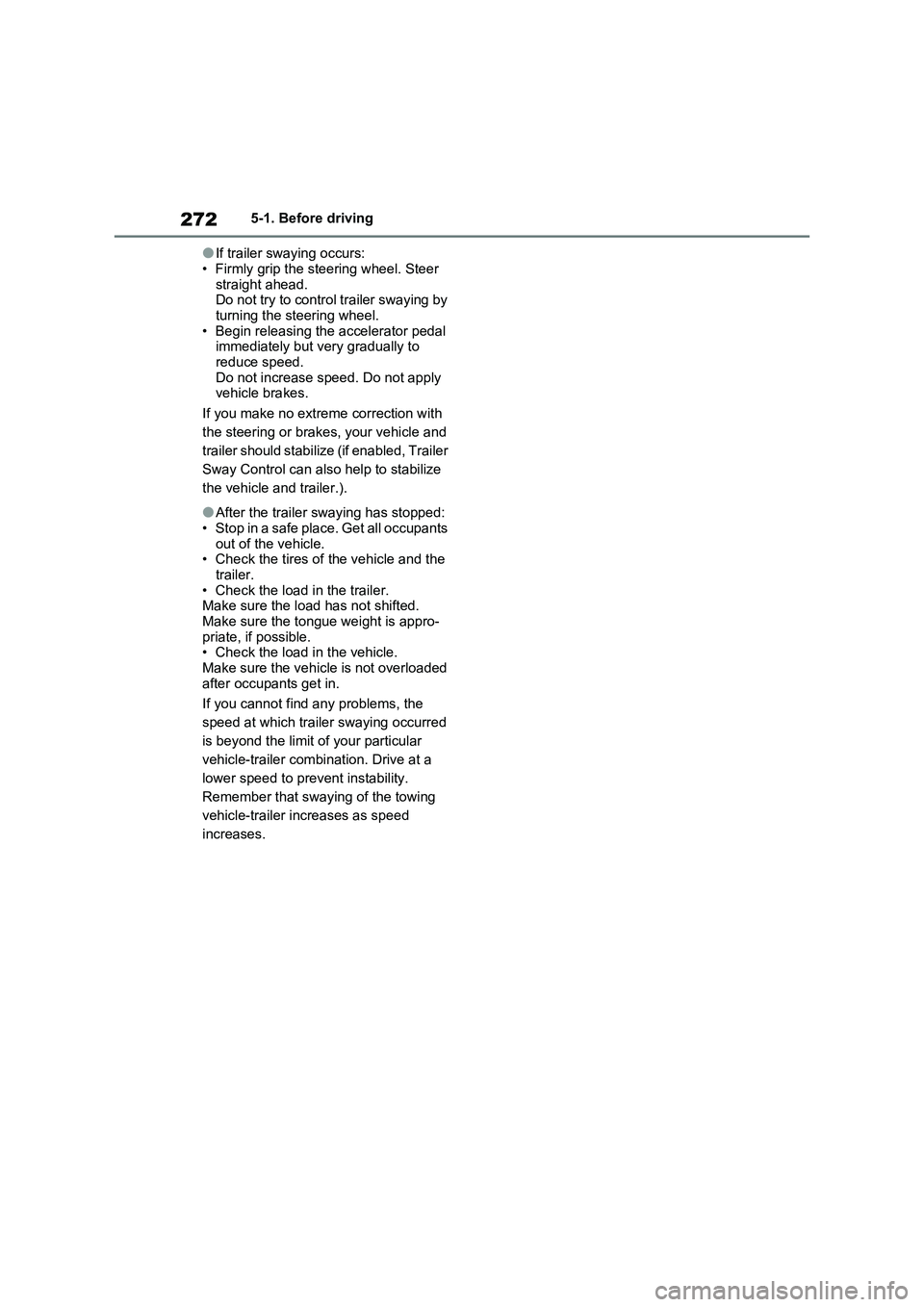
2725-1. Before driving
�OIf trailer swaying occurs:
• Firmly grip the steering wheel. Steer
straight ahead.
Do not try to control trailer swaying by
turning the steering wheel.
• Begin releasing the accelerator pedal
immediately but very gradually to
reduce speed.
Do not increase speed. Do not apply
vehicle brakes.
If you make no extreme correction with
the steering or brakes, your vehicle and
trailer should stabilize (if enabled, Trailer
Sway Control can also help to stabilize
the vehicle and trailer.).
�OAfter the trailer swaying has stopped:
• Stop in a safe place. Get all occupants
out of the vehicle.
• Check the tires of the vehicle and the
trailer.
• Check the load in the trailer.
Make sure the load has not shifted.
Make sure the tongue weight is appro-
priate, if possible.
• Check the load in the vehicle.
Make sure the vehicle is not overloaded
after occupants get in.
If you cannot find any problems, the
speed at which trailer swaying occurred
is beyond the limit of your particular
vehicle-trailer combination. Drive at a
lower speed to prevent instability.
Remember that swaying of the towing
vehicle-trailer increases as speed
increases.
Page 275 of 662
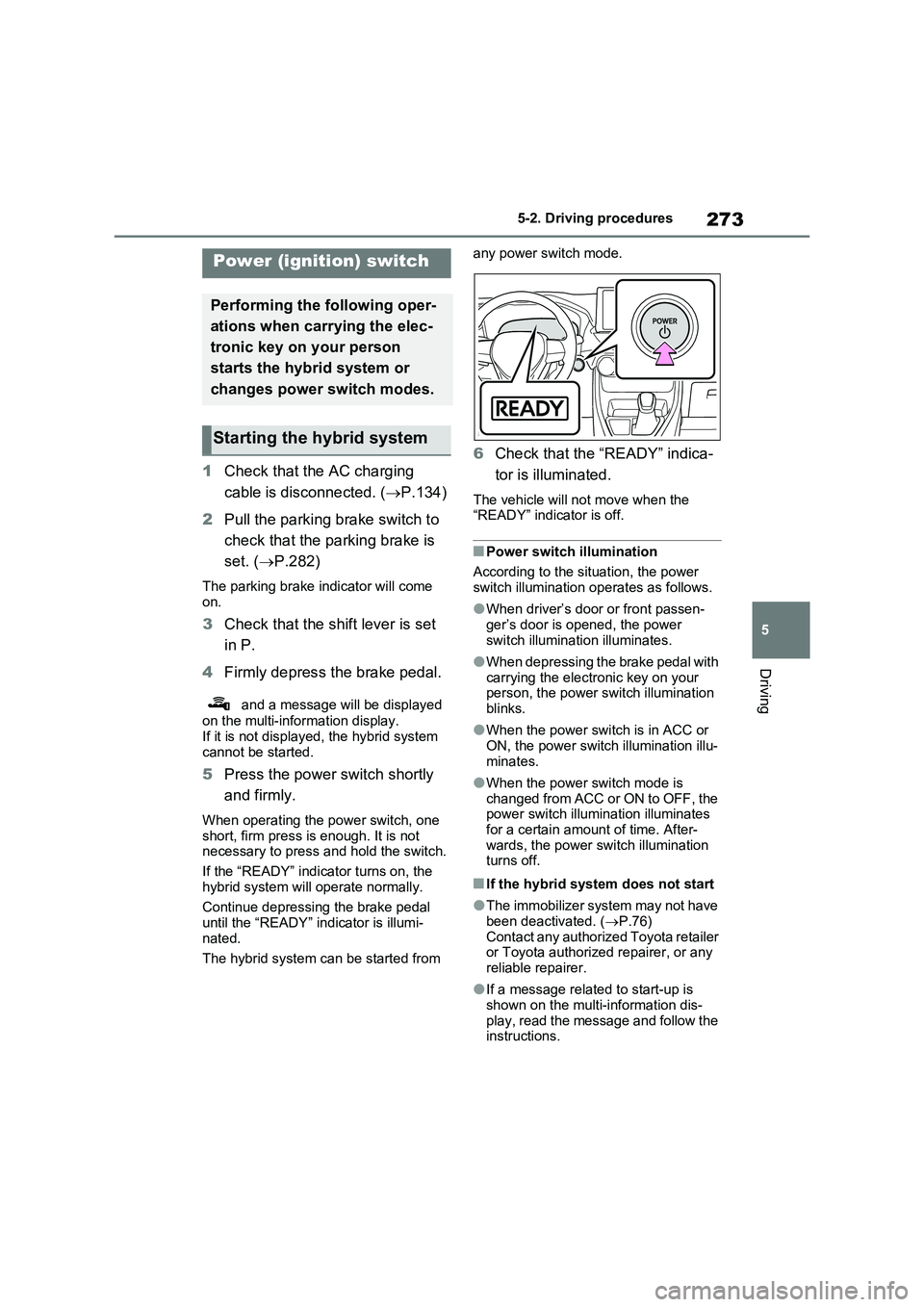
273
5 5-2. Driving procedures
Driving
5-2.Driving pro cedu res
1Check that the AC charging
cable is disconnected. (P.134)
2Pull the parking brake switch to
check that the parking brake is
set. (P.282)
The parking brake indicator will come
on.
3Check that the shift lever is set
in P.
4Firmly depress the brake pedal.
and a message will be displayed
on the multi-information display.
If it is not displayed, the hybrid system
cannot be started.
5Press the power switch shortly
and firmly.
When operating the power switch, one
short, firm press is enough. It is not
necessary to press and hold the switch.
If the “READY” indicator turns on, the
hybrid system will operate normally.
Continue depressing the brake pedal
until the “READY” indicator is illumi-
nated.
The hybrid system can be started from any power switch mode.
6Check that the “READY” indica-
tor is illuminated.
The vehicle will not move when the
“READY” indicator is off.
�QPower switch illumination
According to the situation, the power
switch illumination operates as follows.
�OWhen driver’s door or front passen-
ger’s door is opened, the power
switch illumination illuminates.
�OWhen depressing the brake pedal with
carrying the electronic key on your
person, the power switch illumination
blinks.
�OWhen the power switch is in ACC or
ON, the power switch illumination illu-
minates.
�OWhen the power switch mode is
changed from ACC or ON to OFF, the
power switch illumination illuminates
for a certain amount of time. After-
wards, the power switch illumination
turns off.
�QIf the hybrid system does not start
�OThe immobilizer system may not have
been deactivated. (P.76)
Contact any authorized Toyota retailer
or Toyota authorized repairer, or any
reliable repairer.
�OIf a message related to start-up is
shown on the multi-information dis-
play, read the message and follow the
instructions.
Power (ignition) switch
Performing the following oper-
ations when carrying the elec-
tronic key on your person
starts the hybrid system or
changes power switch modes.
Starting the hybrid system
Page 276 of 662
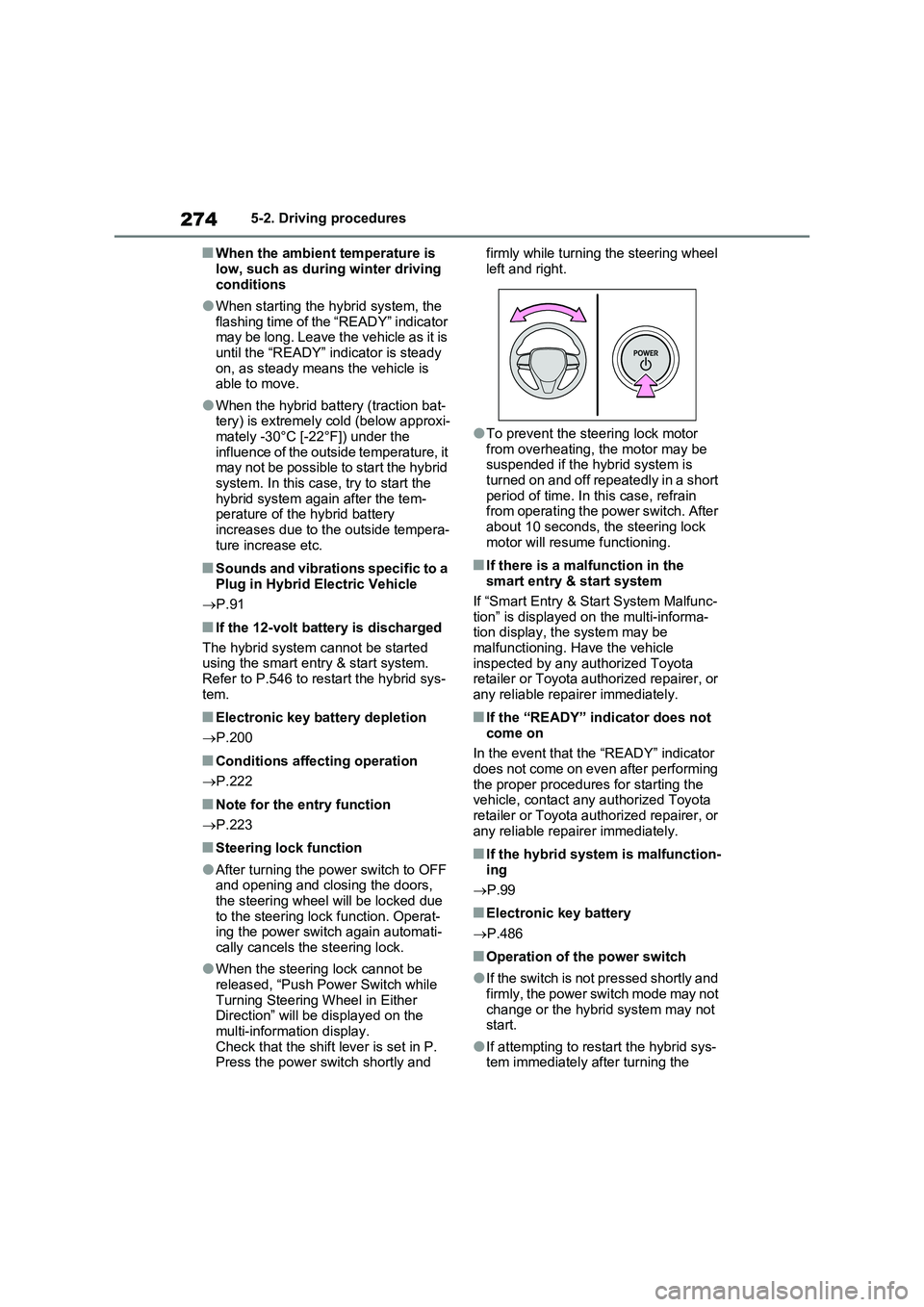
2745-2. Driving procedures
�QWhen the ambient temperature is
low, such as during winter driving
conditions
�OWhen starting the hybrid system, the
flashing time of the “READY” indicator
may be long. Leave the vehicle as it is
until the “READY” indicator is steady
on, as steady means the vehicle is
able to move.
�OWhen the hybrid battery (traction bat-
tery) is extremely cold (below approxi-
mately -30°C [-22°F]) under the
influence of the outside temperature, it
may not be possible to start the hybrid
system. In this case, try to start the
hybrid system again after the tem-
perature of the hybrid battery
increases due to the outside tempera-
ture increase etc.
�QSounds and vibrations specific to a
Plug in Hybrid Electric Vehicle
P.91
�QIf the 12-volt battery is discharged
The hybrid system cannot be started
using the smart entry & start system.
Refer to P.546 to restart the hybrid sys-
tem.
�QElectronic key battery depletion
P.200
�QConditions affecting operation
P.222
�QNote for the entry function
P.223
�QSteering lock function
�OAfter turning the power switch to OFF
and opening and closing the doors,
the steering wheel will be locked due
to the steering lock function. Operat-
ing the power switch again automati-
cally cancels the steering lock.
�OWhen the steering lock cannot be
released, “Push Power Switch while
Turning Steering Wheel in Either
Direction” will be displayed on the
multi-information display.
Check that the shift lever is set in P.
Press the power switch shortly and firmly while turning the steering wheel
left and right.
�OTo prevent the steering lock motor
from overheating, the motor may be
suspended if the hybrid system is
turned on and off repeatedly in a short
period of time. In this case, refrain
from operating the power switch. After
about 10 seconds, the steering lock
motor will resume functioning.
�QIf there is a malfunction in the
smart entry & start system
If “Smart Entry & Start System Malfunc-
tion” is displayed on the multi-informa-
tion display, the system may be
malfunctioning. Have the vehicle
inspected by any authorized Toyota
retailer or Toyota authorized repairer, or
any reliable repairer immediately.
�QIf the “READY” indicator does not
come on
In the event that the “READY” indicator
does not come on even after performing
the proper procedures for starting the
vehicle, contact any authorized Toyota
retailer or Toyota authorized repairer, or
any reliable repairer immediately.
�QIf the hybrid system is malfunction-
ing
P.99
�QElectronic key battery
P.486
�QOperation of the power switch
�OIf the switch is not pressed shortly and
firmly, the power switch mode may not
change or the hybrid system may not
start.
�OIf attempting to restart the hybrid sys-
tem immediately after turning the
Page 277 of 662
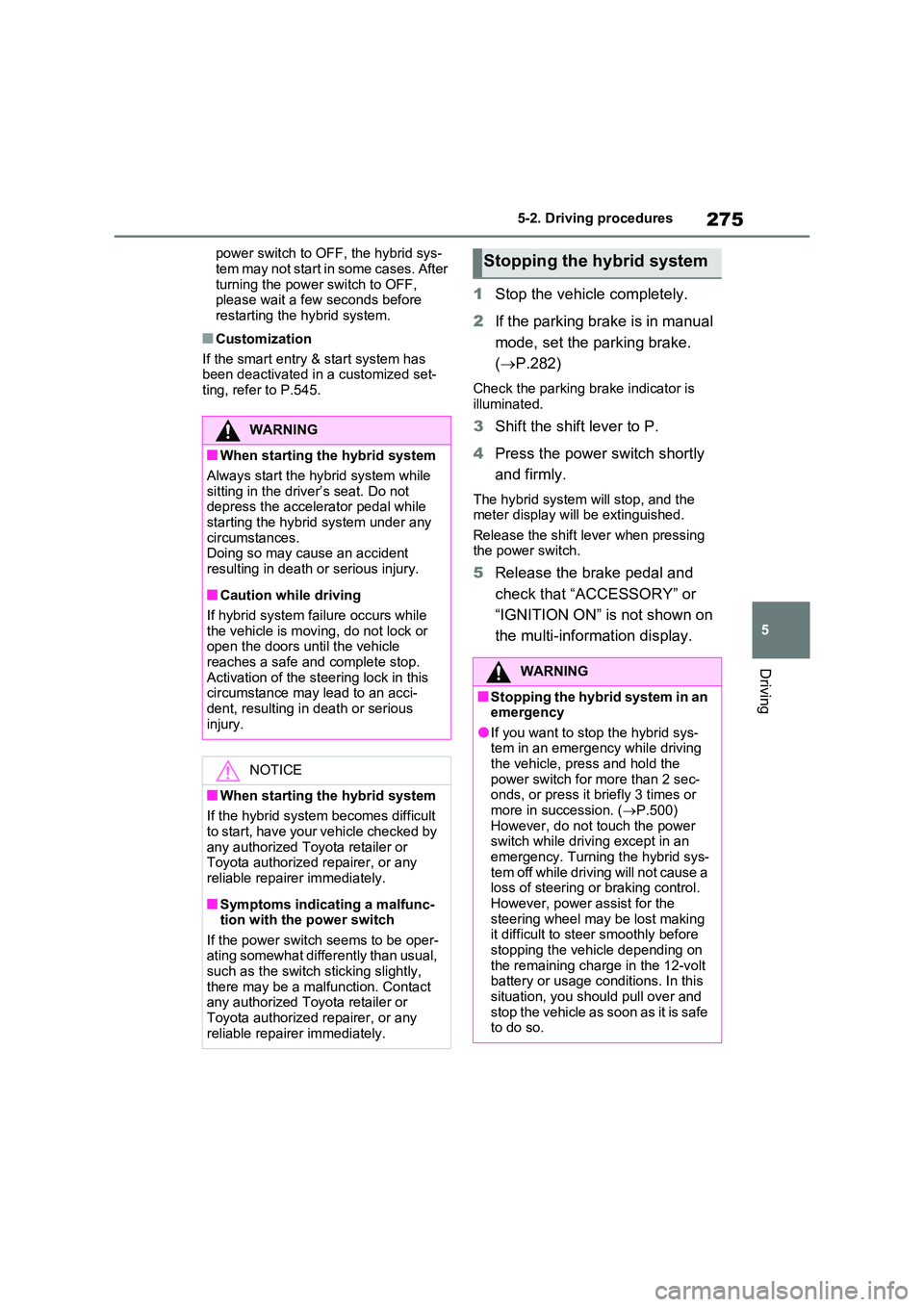
275
5
5-2. Driving procedures
Driving
power switch to OFF, the hybrid sys-
tem may not start in some cases. After turning the power switch to OFF, please wait a few seconds before
restarting the hybrid system.
�QCustomization
If the smart entry & start system has been deactivated in a customized set-
ting, refer to P.545.
1 Stop the vehicle completely.
2 If the parking brake is in manual
mode, set the parking brake.
( P.282)
Check the parking brake indicator is
illuminated.
3 Shift the shift lever to P.
4 Press the power switch shortly
and firmly.
The hybrid system will stop, and the meter display will be extinguished.
Release the shift lever when pressing the power switch.
5 Release the brake pedal and
check that “ACCESSORY” or
“IGNITION ON” is not shown on
the multi-information display.
WARNING
�QWhen starting the hybrid system
Always start the hybrid system while
sitting in the driver’s seat. Do not depress the accelerator pedal while starting the hybrid system under any
circumstances. Doing so may cause an accident resulting in death or serious injury.
�QCaution while driving
If hybrid system failure occurs while
the vehicle is moving, do not lock or open the doors until the vehicle reaches a safe and complete stop.
Activation of the steering lock in this circumstance may lead to an acci-dent, resulting in death or serious
injury.
NOTICE
�QWhen starting the hybrid system
If the hybrid system becomes difficult to start, have your vehicle checked by
any authorized Toyota retailer or Toyota authorized repairer, or any reliable repairer immediately.
�QSymptoms indicating a malfunc-tion with the power switch
If the power switch seems to be oper- ating somewhat differently than usual, such as the switch sticking slightly,
there may be a malfunction. Contact any authorized Toyota retailer or Toyota authorized repairer, or any
reliable repairer immediately.
Stopping the hybrid system
WARNING
�QStopping the hybrid system in an emergency
�OIf you want to stop the hybrid sys-tem in an emergency while driving the vehicle, press and hold the
power switch for more than 2 sec- onds, or press it briefly 3 times or more in succession. ( P.500)
However, do not touch the power switch while driving except in an emergency. Turning the hybrid sys-
tem off while driving will not cause a loss of steering or braking control. However, power assist for the
steering wheel may be lost making it difficult to steer smoothly before stopping the vehicle depending on
the remaining charge in the 12-volt battery or usage conditions. In this situation, you should pull over and
stop the vehicle as soon as it is safe to do so.
Page 278 of 662
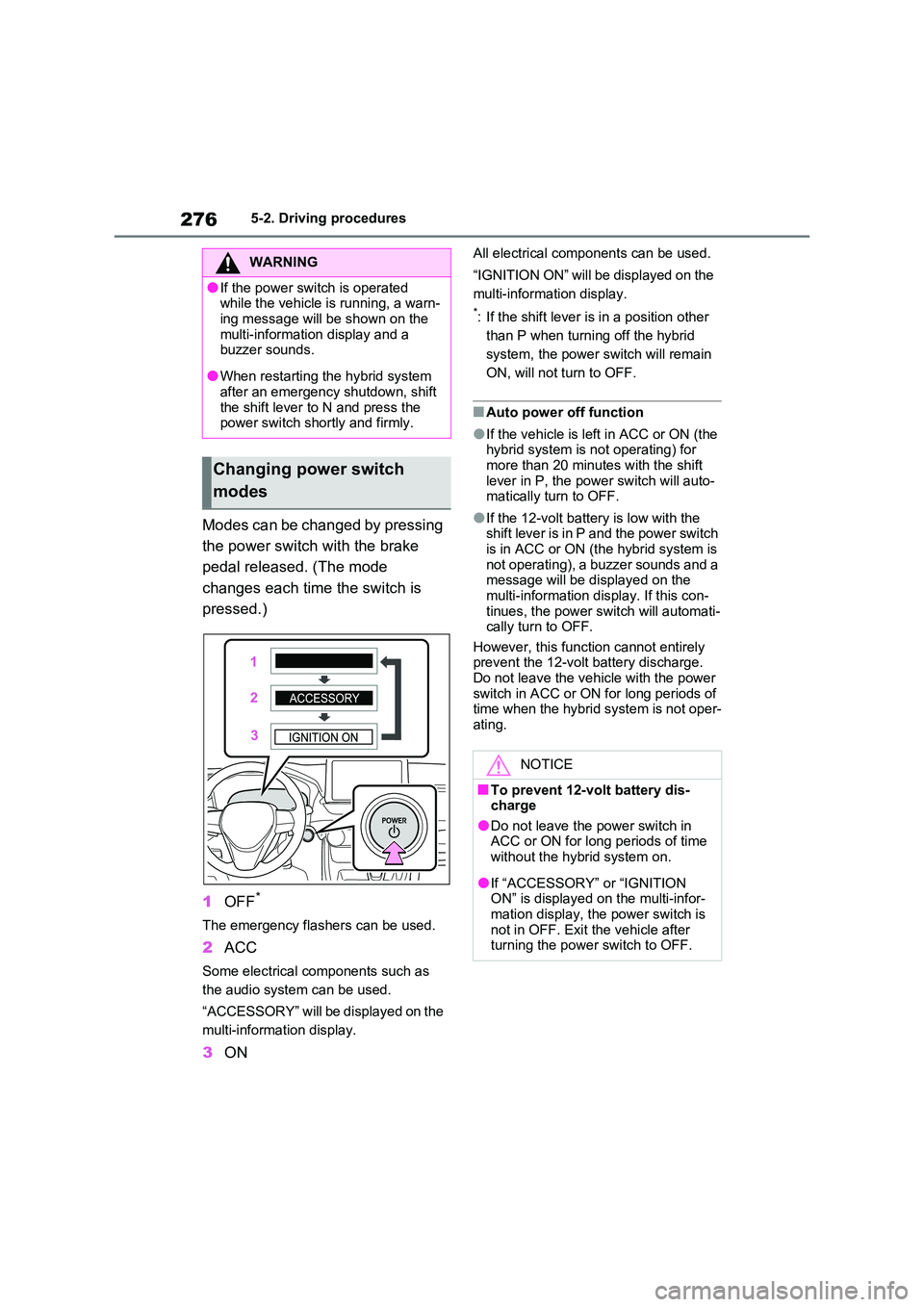
2765-2. Driving procedures
Modes can be changed by pressing
the power switch with the brake
pedal released. (The mode
changes each time the switch is
pressed.)
1 OFF*
The emergency flashers can be used.
2ACC
Some electrical components such as
the audio system can be used.
“ACCESSORY” will be displayed on the
multi-information display.
3 ON
All electrical components can be used.
“IGNITION ON” will be displayed on the
multi-information display.
*: If the shift lever is in a position other
than P when turning off the hybrid
system, the power switch will remain
ON, will not turn to OFF.
�QAuto power off function
�OIf the vehicle is left in ACC or ON (the hybrid system is not operating) for
more than 20 minutes with the shift lever in P, the power switch will auto-matically turn to OFF.
�OIf the 12-volt battery is low with the shift lever is in P and the power switch
is in ACC or ON (the hybrid system is not operating), a buzzer sounds and a message will be displayed on the
multi-information display. If this con- tinues, the power switch will automati-cally turn to OFF.
However, this function cannot entirely prevent the 12-volt battery discharge. Do not leave the vehicle with the power
switch in ACC or ON for long periods of time when the hybrid system is not oper-ating.
WARNING
�OIf the power switch is operated while the vehicle is running, a warn-
ing message will be shown on the multi-information display and a buzzer sounds.
�OWhen restarting the hybrid system after an emergency shutdown, shift
the shift lever to N and press the power switch shortly and firmly.
Changing power switch
modes
NOTICE
�QTo prevent 12-volt battery dis- charge
�ODo not leave the power switch in ACC or ON for long periods of time without the hybrid system on.
�OIf “ACCESSORY” or “IGNITION ON” is displayed on the multi-infor-
mation display, the power switch is not in OFF. Exit the vehicle after turning the power switch to OFF.
Page 279 of 662
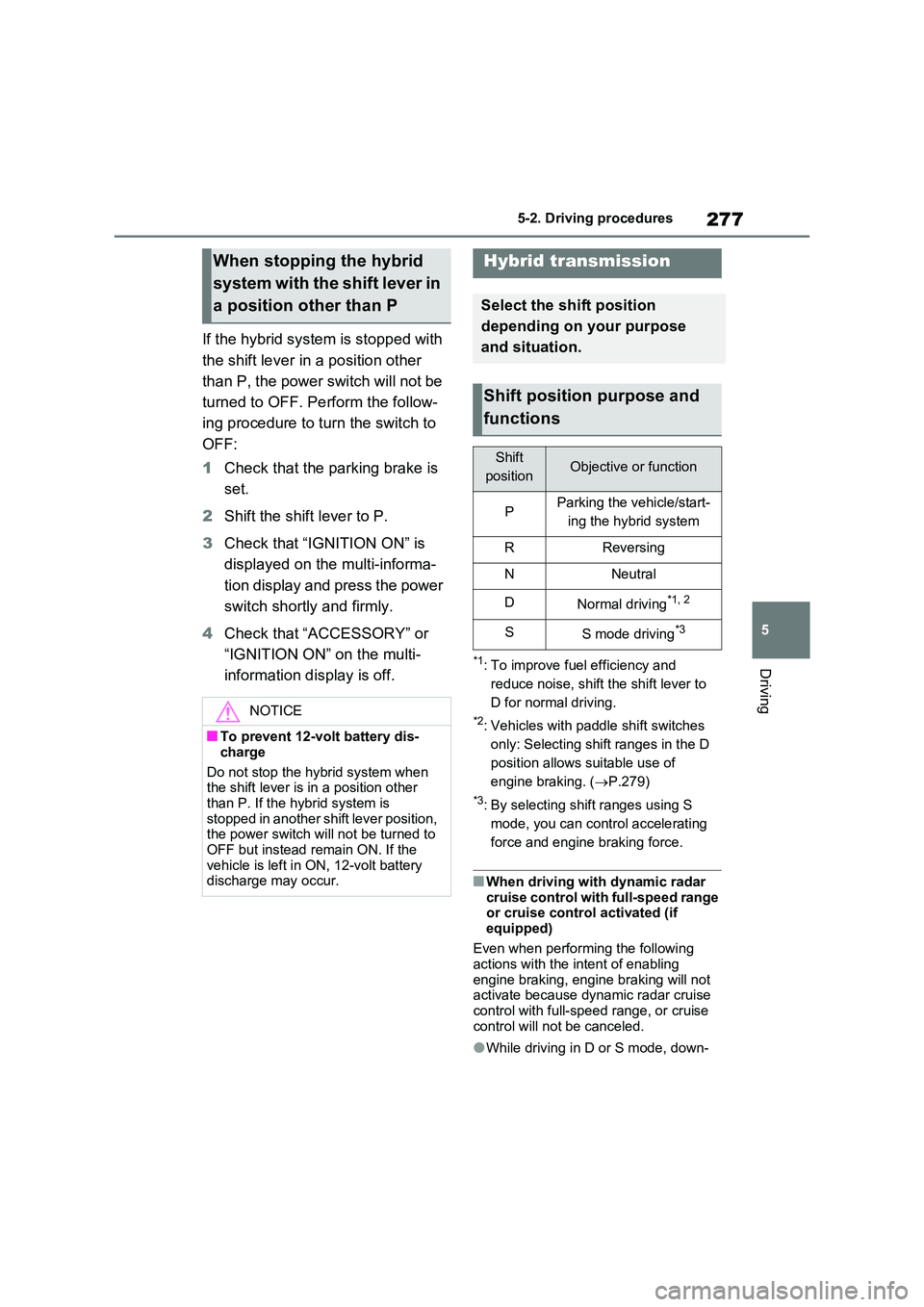
277
5
5-2. Driving procedures
Driving
If the hybrid system is stopped with
the shift lever in a position other
than P, the power switch will not be
turned to OFF. Perform the follow-
ing procedure to turn the switch to
OFF:
1 Check that the parking brake is
set.
2 Shift the shift lever to P.
3 Check that “IGNITION ON” is
displayed on the multi-informa-
tion display and press the power
switch shortly and firmly.
4 Check that “ACCESSORY” or
“IGNITION ON” on the multi-
information display is off.
*1: To improve fuel efficiency and
reduce noise, shift the shift lever to
D for normal driving.
*2: Vehicles with paddle shift switches
only: Selecting shift ranges in the D
position allows suitable use of
engine braking. ( P.279)
*3: By selecting shift ranges using S
mode, you can control accelerating
force and engine braking force.
�QWhen driving with dynamic radar cruise control with full-speed range or cruise control activated (if
equipped)
Even when performing the following actions with the intent of enabling
engine braking, engine braking will not activate because dynamic radar cruise control with full-speed range, or cruise
control will not be canceled.
�OWhile driving in D or S mode, down-
When stopping the hybrid
system with the shift lever in
a position other than P
NOTICE
�QTo prevent 12-volt battery dis-
charge
Do not stop the hybrid system when the shift lever is in a position other
than P. If the hybrid system is stopped in another shift lever position, the power switch will not be turned to
OFF but instead remain ON. If the vehicle is left in ON, 12-volt battery discharge may occur.
Hybrid transmission
Select the shift position
depending on your purpose
and situation.
Shift position purpose and
functions
Shift
positionObjective or function
PParking the vehicle/start-
ing the hybrid system
RReversing
NNeutral
DNormal driving*1, 2
SS mode driving*3
Page 280 of 662
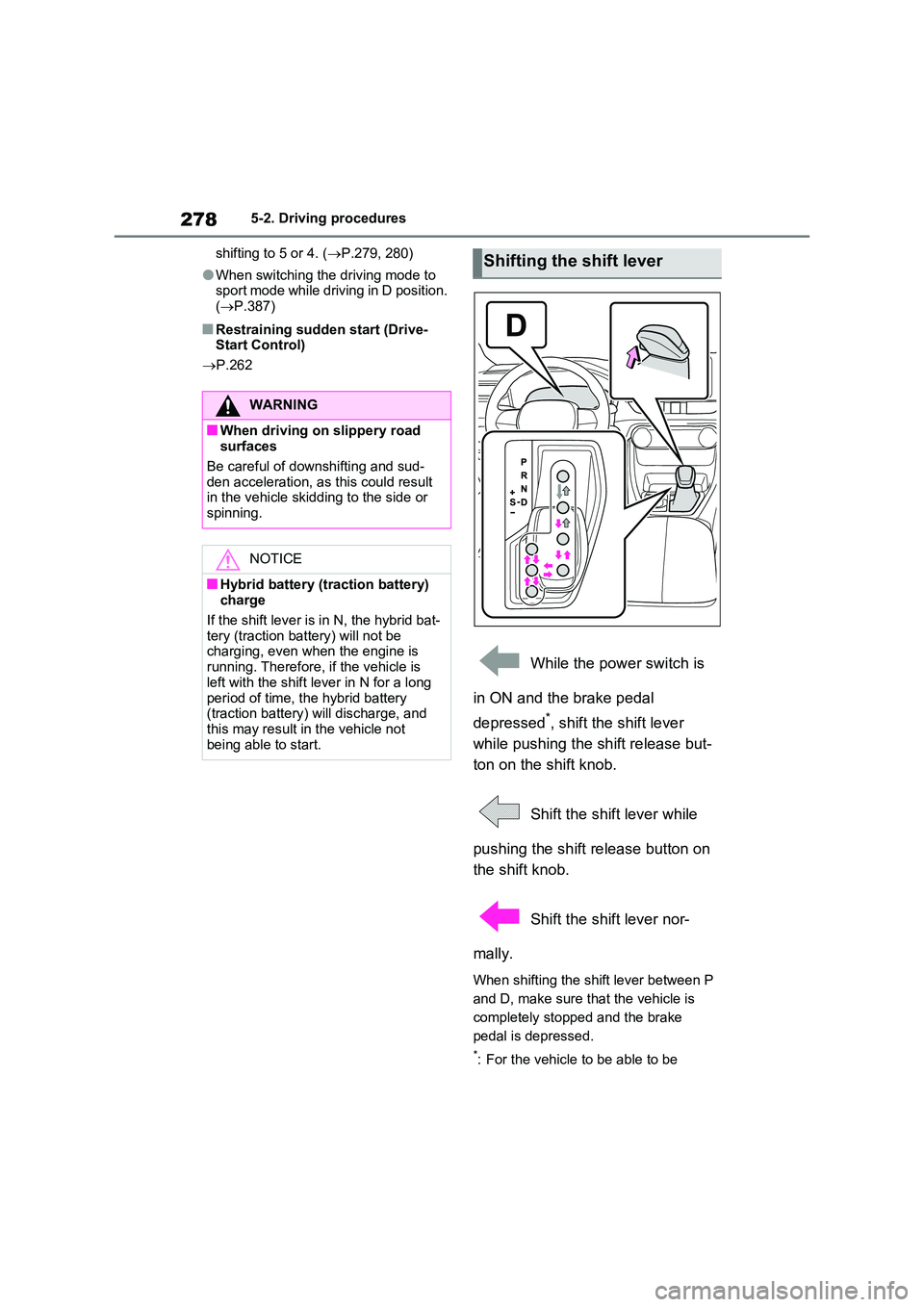
2785-2. Driving procedures
shifting to 5 or 4. ( P.279, 280)
�OWhen switching the driving mode to sport mode while driving in D position.
( P.387)
�QRestraining sudden start (Drive- Start Control)
P.262
While the power switch is
in ON and the brake pedal
depressed*, shift the shift lever
while pushing the shift release but-
ton on the shift knob.
Shift the shift lever while
pushing the shift release button on
the shift knob.
Shift the shift lever nor-
mally.
When shifting the shift lever between P
and D, make sure that the vehicle is
completely stopped and the brake
pedal is depressed.
*: For the vehicle to be able to be
WARNING
�QWhen driving on slippery road surfaces
Be careful of downshifting and sud-
den acceleration, as this could result in the vehicle skidding to the side or spinning.
NOTICE
�QHybrid battery (traction battery) charge
If the shift lever is in N, the hybrid bat- tery (traction battery) will not be charging, even when the engine is
running. Therefore, if the vehicle is left with the shift lever in N for a long
period of time, the hybrid battery (traction battery) will discharge, and this may result in the vehicle not
being able to start.
Shifting the shift lever